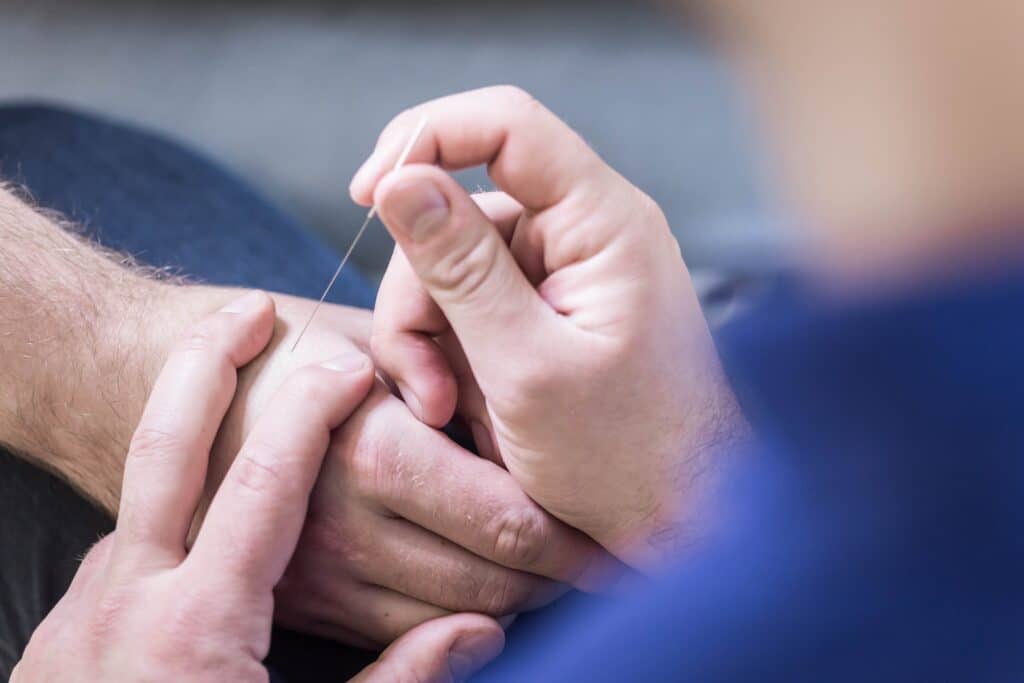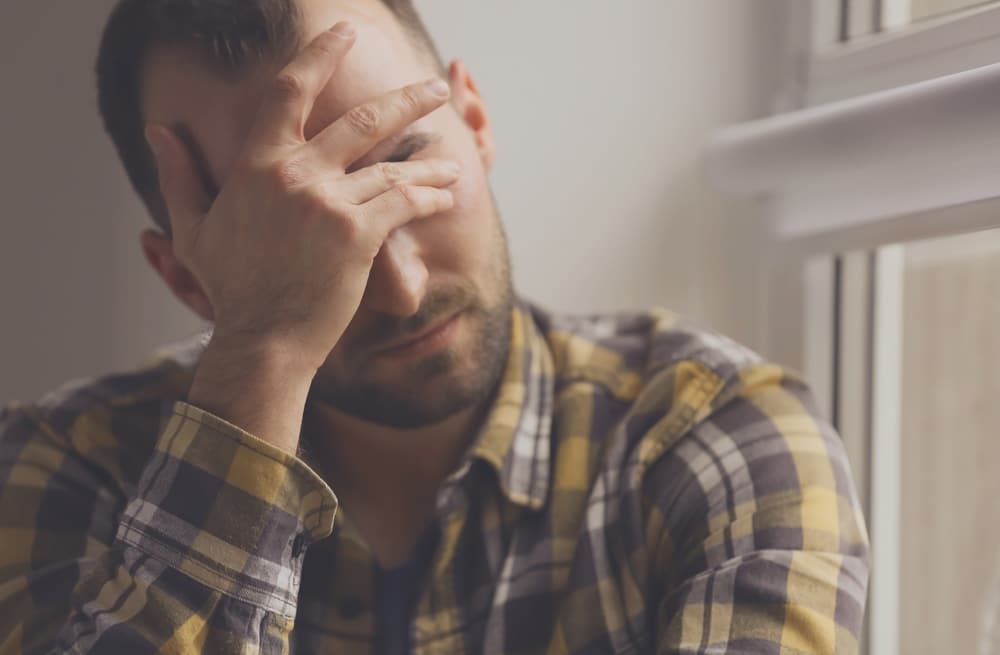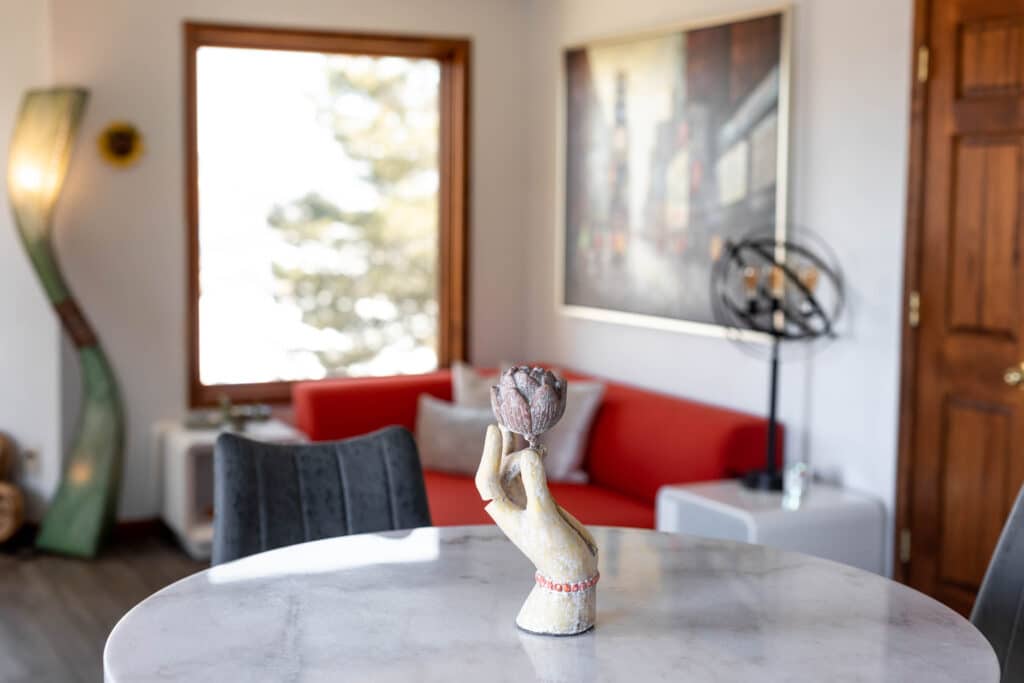Using Acupuncture For Bipolar Depression

Today, there is a great deal of research focusing on alternative or holistic forms of care that can be used as an adjunct or supplemental form of treatment. This research delves into the use of things like acupuncture, meditation, and yoga as a way to handle symptoms of mental health disorders such as major depressive disorder or bipolar disorder. So, is acupuncture for bipolar depression effective? What is Bipolar Depression? Bipolar disorder can present with severe depressive episodes, and for many people, those episodes are treated with medication. However, medication alone is often inadequate for coping with the variety of symptoms that manifest with chronic bipolar depression. The symptoms associated with bipolar depression are the same as those associated with major depressive disorder. At present, there is no cure, and some people might experience depressive episodes exclusively, while others might experience a combination of depressive and hypomanic or manic episodes. No matter the combination, these episodes can present with symptoms severe enough to disrupt daily life and cause significant problems in important areas of functioning like work or school. This is particularly problematic for people who have developed a resistance to current medications. Acupuncture for Bipolar Depression: Studies There are several studies investigating the applicability of acupuncture for bipolar depression. One such study found that individuals who participated in an acupuncture intervention saw decreased depression scores and improvements in physical symptoms with no negative interactions with prescribed medication. In these situations, no changes were made to prescribed medication, but acupuncture led to improved quality of life and symptom management. Other randomized trials reviewed the efficacy of adjunctive acupuncture for bipolar depression over the span of 12 weeks. Symptoms found that all patients had improvement over the span of the study with very few negative side effects and no negative interactions with any other medication or treatment. These studies confirmed the safety and acceptability of acupuncture as a way to manage acute symptoms of bipolar depression. Literature reviews assessed the efficacy of acupuncture for depression, finding that it was generally safe and well tolerated, acceptable as an augmented part of treatment for depression symptoms. While this particular literature review did not focus solely on bipolar depression, symptoms of bipolar depressive episodes and depression are the same. In fact, other studies reviewed the efficacy of acupuncture for mood disorders, including major depressive disorder and bipolar disorder with depression, paying close attention to those who had treatment-resistant forms of both. The longitudinal study performed weekly acupuncture treatments for 12 weeks in addition to regular treatment. Findings revealed that physical symptoms improved for things like: Other improvements included: While acupuncture did not necessarily improve all psychiatric symptoms of bipolar depression, it was efficacious enough to alleviate some of the majority of symptoms experienced by patients. This has a great deal of promise for individuals with treatment-resistant forms of bipolar depression who are looking for holistic ways to manage a few, if not a majority, of their symptoms. Starting Acupuncture for Bipolar Depression There are many forms of treatment out there for bipolar depression episodes. At The Differents, we specialize in flexible outpatient programs that allow clients to see the benefits of their treatment in real time, returning home each night to apply the techniques and tools learned during the day. We offer a wide range of evidence-based practices including: With our acupuncture and chiropractic practices, clients who struggle with bipolar depression can find alternative holistic therapies at our luxury drug rehab facility. We work hard to reimagine the rehab process so that individuals with co-occurring mental health and substance abuse disorders can find a holistic program that is most supportive, one that cultivates creativity, and feels as though they are working with staff who not only understand and genuinely care about your recovery. Studies have found that holistic alternatives can prove useful in treating mental health conditions. One of those is acupuncture for bipolar depression. If you want to explore alternative options that can be used in conjunction with individual and group therapy, we are here. Contact The Differents today at (844) 407-0461 to see how our facility can help you.
Are Gateway Drugs Real?

Many people have heard of gateway drugs and seen government-sponsored advertisements on television throughout the years that have spoken of the influence that a single drug can lead to a lifetime of abuse. But are gateway drugs real? What Are Gateway Drugs? “Gateway drugs” is a term applied to any type of drug that acts as a stepping stone to later using other drugs. In this context, that means any type of drug that leads to another drug. Theoretically, this means that trying one type of substance or drug could lead you to trying another and another, and eventually working your way to drugs that are the most highly addictive and potentially damaging. Are Gateway Drugs Real? Yes, gateway drugs are real. However, it’s important to take into consideration aspects like: For example, marijuana is not necessarily a gateway drug, even if it is portrayed that way, as it does not change the way the brain functions the same way that other drugs do. In order for a drug to be considered a gateway drug, it has to have a profound enough change in the brain size, structure, and function that leads to issues with impulse control and addiction. Certain drugs can change the sizes of parts of the brain like the prefrontal cortex and the amygdala. The prefrontal cortex is a part of the brain responsible for impulse control and good decision-making. Under normal circumstances, this part of the brain is physically balanced with the amygdala, meaning that they are around the same size so they can balance each other out. But with gateway drugs, changes are made such that the amygdala gets bigger and the prefrontal cortex physically shrinks. When this area of the brain gets physically smaller, it can’t work as hard as bigger areas like the amygdala. The amygdala is responsible for impulsivity, and it can lead to poor decision-making, such as choosing a more addictive substance like heroin when you are out of your prescription opioids. There is another way that gateway drugs can affect you: using a drug that may have been mixed with another. The more often you use illegal drugs, the less control you have over the purity of the drug, and this can result in unexpectedly or unintentionally consuming more addictive drugs. One of the biggest gateway drugs in America is opioids. Opioids are often prescribed for chronic pain or pain management after surgery, but a person may develop a dependence on their opioid medication, leading to the development of an addiction. Over time, that addiction can mean that someone who originally started with a low dose of a prescription opioid might turn to higher doses from other prescriptions and eventually toward illegal opioids like fentanyl and heroin. Getting Treatment for Addiction Evidence indicates that some drugs do act as a gateway, particularly things like prescription opioids. If you find yourself addicted to substances like alcohol or opioids, you might need medication-assisted treatment. Medication-assisted treatment, or MAT, can help reduce cravings and lessen withdrawal symptoms. MAT with The Differents At The Differents, our team specializes in a wide range of services and addiction treatment programs. One of our treatment services is MAT. As a qualifying facility, our team will work with you to devise a unique treatment plan that incorporates initial detox and subsequent therapy. Starting with detox, we will provide FDA-approved medications that help to reduce the severity of your withdrawal symptoms. Over-the-counter medications are also used to help keep you as comfortable as possible during this process. Our team will make sure that your vitals are monitored and any changes or potential complications are treated accordingly. After you get through detox, we will help you transition to your next steps with reimagined treatment programs. Our goal is to incorporate evidence-based practice alongside holistic care to give you a complete mind-body approach to your treatment. A big part of this is recognizing the factors that may have contributed to starting with gateway drugs and the steps that led from one drug to another. Understanding this process can help you reflect on what changes you might want to make in your lifestyle moving forward. Overall, gateway drugs can be real, and abusing one substance may often lead to abusing additional substances, which increases your risk of addiction and further complications. However, with the right type of treatment, you can get help for addiction today and start living a happier, healthier life. Contact our team to learn more about our programs.
What Are the Signs of Drug Addiction?

If you or someone you love is struggling with mood swings, money problems, irritability, and similar symptoms, you might wonder if these changes represent symptoms of addiction. Some of the common symptoms of drug addiction are physical symptoms–which happen while under the influence or during withdrawal–and these can include shaking, chills, muscle pain, or cramps. But many of the symptoms that a family member or close friend might notice extend to behavioral issues such as severe mood swings, paranoia, sudden lying or stealing, or experiencing legal issues because of drug use. An individual struggling with addiction might notice that in addition to their mood swings and changes in behavior, they keep forgetting to do important things like go to work or pick up their kids from school because they are focused exclusively on drug use. Thankfully, no matter what, there are ways you can get help with The Differents, an addiction treatment center in Nevada. Physical Symptoms of Addiction Physical symptoms of addiction have the widest range and depend on the substances being used. For example, someone might experience: Behavioral Signs of Drug Addiction The symptoms of addiction might vary from one substance to the next in physical manifestations, but there are similar behavioral signs. Mood Swings Mood swings and irritability without cause happen often. Someone you know might be an otherwise even-keeled person, but soon, they start to show signs of drug addiction like rapid mood shifts, being particularly irritable for no reason, or snapping at small things that don’t matter. Lack of Responsibility Another common feature of drug addiction is a lack of responsibility. Individuals might forget to do important things for work or personal life because they are preoccupied with obtaining, using, or recovering from drugs. This can include being late to work regularly or even skipping work without calling in or having an explanation. Paranoia Some substances lead to extreme paranoia. This can manifest similarly to mood swings, and someone with an addiction might make accusations of people taking things from them, conspiring against them, or trying to harm them. In other cases, individuals might demonstrate paranoia about their environment, checking windows continually, keeping doors locked and curtains shut, and always hesitating when someone comes to the door. Lying or Hiding It is not uncommon for someone dealing with addiction to start lying or hiding information about where they were or how they got money. This lying can happen when someone tries to mask their addiction, and it might not always make sense or be believable. Other Symptoms of Addiction Other signs of drug addiction are interrelated, such as financial problems, bad habits, lying, or stealing. Financial Strain It is not uncommon for people struggling with addiction to start to experience financial strain. That strain can come in many forms, such as: Legal Issues This financial strain can be exacerbated by legal issues like: These legal issues come with fines as well as potential jail time, probation, or court-ordered classes and volunteering. Many of the most significant symptoms of addiction revolve around the development of tolerance. An individual might start taking more and more of a particular substance in order to achieve the same effect. Moreover, that same person might try to stop or reduce their drug use and find that no matter what they do, they can’t seem to quit. It’s not uncommon for individuals to reach a point where they truly want to quit, and yet, despite understanding all of the negative consequences addiction has, they are unable to. Getting Help with Symptoms of Addiction Once you notice signs of addiction in yourself or a loved one, it is important to reach out for help. The Differents offers clients several levels of care, including PHP, IOP, and programs specific to groups like first responders. Our Reno substance abuse treatment programs are intended to help those in need with a remote, exclusive location nestled in the Sierra Nevada Mountains, just minutes from Lake Tahoe. The serene backdrop makes it easy for clients to step away from their daily stress and focus on turning attention inward and rebuilding what addiction may have broken. Overall, the symptoms of addiction can look different from one substance to the next but revolve around physical symptoms, behavioral symptoms, and other symptoms. Learning to recognize them can help you decide when it is time to get help.Call The Differents today to learn more about common signs of addiction and how our trusted drug rehab in Reno can help.
Recovery During the Holidays: Navigating Triggers and Staying Sober

Recovery during the holidays can be challenging. Whether this is your first holiday season staying sober or your seventieth, the stress that comes from holiday events, traditions, family get-togethers, family fights, expectations, financial pressure, and more can make it difficult to avoid triggers, let alone stay sober. How to Maintain Recovery During the Holidays During the holiday season, take time to check in with yourself, especially if this is the first holiday where you are trying to remain sober. It’s easy to feel angry, overwhelmed, or anxious, which are perfectly normal feelings. However, if you don’t take time to assess how you are feeling and what you can do to manage those emotions, those normal feelings might lead to a relapse. That’s why it’s important to have strategies for navigating triggers and maintaining sobriety during the holidays. Be Open and Honest Be open and honest about your recovery. The holiday season is particularly stressful for many people because of how big a role alcohol or drug use might play in events or parties. It’s important to be open and honest about your journey in recovery so that other people understand and respect your wishes. Don’t let someone pressure you with the old adage that “one drink won’t hurt.” Instead, avoid stressful or potentially vulnerable situations, and for other events, consider bringing non-alcoholic beverages. You might be surprised at how many other people, for whatever reason, are also staying sober and might appreciate an opportunity to still socialize with a tasty beverage that won’t get them into trouble. Self-Care Sobriety during the holidays is best done when you have an established self-care routine. Techniques that you may have learned from therapy or support groups can be particularly useful when practiced all year round, but they can be especially important when you face extra stress and triggers during the holiday season. Maintaining sobriety during the holidays is a lot easier if you plan ahead. By planning ahead, you can: Get Support Get support. Help can come in so many forms, like a sponsor, a friend, or someone who sympathizes with what you are going through. You might need to schedule extra support group meetings or group therapy sessions so that you are in a good place and have the skills to maintain your emotional bandwidth at parties or events. You might even consider getting professional support from The Differents, where you can participate in our Reno intensive outpatient programs or partial hospitalization programs right before the stress of the holiday season begins to build. Change Your Focus Maintaining recovery during the holidays might mean changing your focus. While you will likely expend a lot of energy checking in with yourself and how you are feeling, you can also go back to some of the basic tenets of SMART and 12-step programs, which is to give back and see how you can serve others. When you change your focus, you can get a much bigger picture of what’s happening in the world and gain some perspective about your issues with recovery. It can also offer an opportunity to deepen your connection with others and focus on the things that matter most during an otherwise complicated holiday season. Overall, what matters most is that you know your limits and that you know when and how to reach out to others if you are in need. There’s really no way to avoid all triggers during the holiday season, but what you can do is apply techniques and tools to navigate those triggers and cope with the stress instead of letting it encourage a relapse. Let The Differents lend a helping hand if you are struggling with your recovery this holiday season. Contact our trusted drug rehab in Reno today.
Overcoming Guilt and Shame in Addiction Recovery

Guilt and shame go hand in hand with addiction and recovery. Addiction affects the individuals with an addiction and those around them. Given this reach, clients who want to get help may have many sources of guilt and shame that they may want to overcome during addiction recovery. Read on to see how our addiction treatment center in Nevada can help. Shame in Addiction Recovery Shame in addiction recovery looks different for everyone. Consider these two different examples of individuals facing guilt and shame. Martin Let’s consider Martin. Martin traveled overseas for several years when he was young. After returning to the U.S., Martin was addicted to nicotine but was still too young to legally buy cigarettes. During several of his lowest points, Martin would pick up used cigarette butts from the ground and smoke what was left on them. He felt so ashamed and never told anyone about this for fear of being judged. He carried this shame and guilt with him as he turned to other substances he could more easily get in his neighborhood from dealers, and it colored his perspective of his value and worth. Carey Carey had a complicated history of drug abuse. She started with marijuana when she was a teenager, but after entering an abusive relationship, she began to use cocaine and other stimulants when she wanted to stay awake in order to ensure she was safe. This abusive relationship often made her fear for her life and that of her family. Carey found herself facing legal trouble over possession and went to outpatient drug rehab programs several times. She never finished these programs, though, and she relapsed often. Carey knew that her addiction was hurting the family who loved her, like her parents. At times, she moved back in with them but would sneak out at night to get high and wake up later, not realizing she had scared her parents by not being home, leaving their house a mess, or screaming at them. Carey felt deep shame and guilt over how she affected her family but could never express it to anyone, not even them. She didn’t bother to apologize, believing her family thought the worst of her and that it wouldn’t matter. Getting Help Overcoming Shame in Addiction Recovery with The Differents At our Reno substance abuse treatment center, we offer several avenues to overcoming guilt in addiction, such as: Mindfulness and Meditation Mindfulness and meditation are viable tools for dealing with guilt during recovery because they help you better identify your emotional state at any given time by learning to sit with your feelings, acknowledge them, and accept them without judgment. CBT and DBT Psychotherapies like CBT and DBT can help you reflect on what situations or circumstances in your past may have contributed to current feelings of guilt or shame. In some cases, these feelings are because of negative automatic thoughts that continue to color your perceptions and self-image. Through individual and group therapy sessions, you can learn to replace these negative automatic thoughts with positive ones and change how you view yourself and your struggles with addiction. Family Therapy At our facility, our family therapy sessions involve your closest family members and provide a safe space to rebuild your relationships through open communication and healing. Family therapy provides a place to better understand the way addiction works, the influence it has on those around you, and ways to develop healthy coping strategies as a family. This can often involve overcoming guilt for the ways you may have hurt those closest to you or how they have hurt you through things like lack of support or not encouraging your recovery. Educational Resources A big part of guilt during the recovery journey comes from not understanding how addiction works. That is why we provide educational resources for individuals and families that help everyone better understand the process of addiction and recovery. These resources can help you and your loved ones set healthy boundaries and help you learn how to care for yourself. Our resources provide actionable information on overcoming shame in addiction recovery. Support Groups Shame in addiction recovery is often the result of feeling as though you are the only person who has gone through your experiences, damaged relationships or opportunities because of addiction, or made decisions that you weren’t proud of. But this couldn’t be further from the truth. We facilitate support groups for individuals and their families that provide an environment where everyone can share their experiences, gain insights from other participants, and receive professional guidance. The Differents Can Help These programs can shed light on how you and other people struggling with addiction are beholden to neurological changes brought about by drug and alcohol use, helping you recognize that you are not defined by those changes or by the mistakes you’ve made, and you can work towards overcoming any lingering guilt and shame during recovery.Contact our trusted drug rehab in Reno today to learn how you can deal with guilt in recovery with The Differents.
The Role of Forgiveness in Addiction Recovery

Addiction is a chronic condition, the effects of which can spread from the person with an addiction to their loved ones. If you or someone close to you is struggling with addiction, you can increase the chances of recovery by offering and accepting forgiveness. Why Forgiveness Matters If you don’t forgive yourself, you are more likely to harbor negative thoughts about yourself and have low self-esteem, which can lead to relapse. If you truly believe that you are a bad person or you’re incapable of change, it’s more likely that you will see every setback as confirmation of the incorrect belief and let it stop your progress. If you have a family member who has struggled with addiction, you need to forgive them so that you can repair the relationship and support them in their recovery. Individuals are more likely to complete drug and alcohol rehab programs and maintain sobriety long-term if they have support and involvement from their family or close friends. Forgiveness in Addiction Recovery: Forgiveness of the Self and Others When you seek professional help for addiction, many of the therapeutic opportunities you have provide a chance for deep reflection and getting to know yourself. During these sessions, you’ll have a chance to review what aspects of your life may have contributed to addiction, how your addiction may have hurt those around you, and what negative automatic thoughts you have about yourself. Forgiving Yourself Negative automatic thoughts like guilt and shame can come from knowing that you have stumbled along your path and chosen things that have hurt yourself or others. It’s not uncommon to let these feelings define who you are when struggling with addiction, but it shouldn’t be that way. With addiction, your full recovery comes when you learn to forgive yourself for the mistakes you’ve made. By forgiving yourself, you can learn to build your self-esteem and recognize your true potential. Therapies like cognitive behavioral therapy can include sessions where you identify negative automatic thoughts stemming from low self-esteem and feelings of resentment or shame about yourself. You can learn strategies for changing these automatic thoughts to positive versions and forgiving yourself. Everyone makes mistakes, and everyone has failures, but they’re only bad if you can’t learn from them, and you can’t learn from them if you don’t learn to forgive yourself. Forgiving Others If you have a loved one who has struggled with addiction, you also play an important role in recovery. Addiction and forgiveness are concepts that have to apply to everyone who is touched by the chronic condition. If your spouse, parent, sibling, child, or even close friend has struggled with addiction and is in recovery, you’ll need to be aware of how important it is for you to offer them forgiveness for mistakes they have made. This might take place in family therapy sessions or support group sessions. It’s not uncommon for addiction to cause a great deal of mistrust, damage relationships, hinder communication, and make every party involved feel as though they are stuck and can’t move forward or rebuild their bonds. But forgiveness in addiction recovery helps rebuild these broken aspects of relationships. Addiction and Forgiveness with The Differents In each of our programs at our Nevada addiction treatment center, clients benefit from several therapies, including forgiveness in addiction recovery. With our Reno partial hospitalization program, intensive outpatient program, and withdrawal management programs, clients can enjoy holistic treatment, including: Each of these holistic treatments is there to enhance forgiveness in addiction recovery by encouraging self-awareness–so that you might know better what you need from those around you–and reflections on what has led to addiction–so that you might ask forgiveness of those who were affected by it. Forgiveness plays an essential role in moving forward in recovery. Without it, you will find yourself tripping emotionally and mentally over barriers on your path that won’t be resolved until forgiveness is given. At The Differents, we know that addiction and forgiveness go hand in hand, so we work hard to ensure you can achieve it during your time with us. Contact us today to learn more about forgiveness in addiction recovery and how our holistic care can put you on the right path.
Is Luxury Rehab Worth the Investment?

The word “luxury” is frequently used by drug and alcohol rehab centers, but what does it actually mean? And how do you filter out facilities that are luxury in name only? What is luxury rehab? The defining characteristics of a luxury rehab are: Comfort: your treatment will be in a modern plush facility. You should expect, and demand, a private single en-suite bedroom with a private bathroom. High-end rehabs that offer detox programs should also have a physician experienced with detox who can prescribe so-called comfort medication to ease any withdrawal symptoms during your first days in treatment. Privacy & Confidentiality: luxury rehabs are the preferred choice for executive professionals, athletes, celebrities and others who are in the public eye. These facilities are used to catering to clients to whom privacy is important. Additionally, these clients appreciate that they will have a peer-group of other clients similar to themselves with relatable life experiences. Experienced Staff: staff turnover can be quite high in the recovery industry, particularly in lower-end facilities where staffing levels are low and burnout is high. The senior clinical staff at a luxury rehab will consist of Therapists, Nurses and Directors with many years of experience at a small number of treatment centers. Is luxury rehab worth it? For the price of luxury rehab you receive a higher level of care, more comfortable surroundings and accommodations, experienced staff and plenty of additional amenities. However, this is only part of the benefit. The most important value of a luxury rehab is that the client is more likely to complete the course of treatment. How long is the average rehab stay? A typical stay at a rehab facility is at least 30 days. However, according to data published by the Substance Abuse and Mental Health Services Administration (SAMHSA), only 42% of individuals who enter treatment for drug and alcohol abuse complete it. This is a sobering statistic, but not a terribly surprising one. The process of getting sober takes considerable effort, and without comfortable surroundings it can feel overwhelming, leading many to abandon their recovery program. The majority of addiction treatment centers are “institutional” in nature – similar to a hospital, frequently with 2-4 beds to a room. A luxury rehab, by comparison, should feel more like a vacation home or even a spa retreat. If you want the best chances for you or a loved one to achieve and maintain sobriety, the truth is it’s easier in a luxurious environment. Some rehabs are luxury in name only While many rehabs brand themselves as high-end, you should investigate to make sure they are capable of delivering what they promise. Here are some potential red flags to look out for: he pictures on the website show the same one or two rooms from multiple angles (because they only decorated the living room) Lots of exterior pictures showing the yard, maybe a pool, but no pictures of the bedrooms No video walk-through tour of the facility. This is critical to get a true sense of the size and comfort of the rehab. No bios or pictures of the staff (because they probably turn over too frequently) Pictures of horses. Seriously. Many “luxury” rehabs do offer equine therapy, but it’s typically not on-site and most equine therapy centers do not allow you to ride the horses. Don’t expect to see horses during your stay. (We’re working on our stables now, but no pictures until it’s real.) Extra Amenities and Experiences Luxury rehab facilities often take a holistic approach to addiction treatment, addressing the physical, emotional, and spiritual aspects of recovery. This means that in addition to traditional therapy and medical care, you may have access to alternative treatments like acupuncture, massage, and nutritional counseling. These services can help you heal your body and mind, reduce stress and anxiety, and improve your overall well-being. By taking a holistic approach to recovery, luxury rehab facilities can help you achieve lasting sobriety and a healthier, happier life. At The Differents we also emphasize creative activities for self-expression and emotional healing as well as entertainment throughout the property. We have a full-size indoor basketball court with parquet floors, a bowling alley, gymnasium, putting green and more. The value of this is beyond recreation. Socializing with peers and making lifelong friends is a part of the rehab experience, and having fun social activities fosters the therapeutic benefits that come from these relationships. Long-Term Support and Aftercare Another major benefit of investing in luxury drug rehab is the long-term support and aftercare that is often provided. A luxury rehab should offer ongoing support and resources to help you maintain your sobriety and prevent relapse. This may include regular check-ins with a therapist or counselor, access to support groups, and continued access to alternative therapies like yoga or meditation. By providing ongoing support, luxury rehab facilities can help you build a strong foundation for lasting recovery.
A Rehab Renaissance

Addiction is a complex problem, and approaches to rehab have evolved considerably in recent years. At The Differents, we offer integrated care and innovative approaches with emerging technologies to help individuals find meaningful life beyond addiction. If you or a loved one is struggling with addiction, you might feel lost as to what to do. We want you to know there is hope, and there are solutions. However, there are several approaches to drug and alcohol rehab that are no longer considered effective. We want to identify some of these outdated approaches first, then share how we offer a new kind of rehab that leads to more successful outcomes. Outdated approach #1: Cold turkey detox This involves abruptly stopping drug or alcohol use without any medical assistance or support. This approach can be dangerous and ineffective, as withdrawal symptoms can be severe and even life-threatening. Outdated approach #2: Confrontational interventions Interventions were once thought to be lifesaving actions, and, even if you have never participated in one, you have probably seen them depicted in movies or TV. This approach involves confronting the individual about their addiction, often with family members and friends sharing how hurt they have been in the process. However, this approach is no longer recommended as it can often lead to feelings of anger and defensiveness in the person at the center of the intervention, which can make it harder for that individual to want to get help. There’s also a sort of catch-22 with interventions. They only work if an individual desires to get sober, but if they desire to get sober then they don’t need the intervention. Outdated approach #3: Boot camp-style programs These programs involve strict and often harsh discipline and punishment for drug and alcohol use. While they may work for some people, they can also be traumatizing and have negative long-term effects on mental health and self-esteem, especially in teenagers and young adults. Addiction is punishment enough, and those suffering from it don’t need additional pain. Outdated approach #4: One-size-fits-all treatment plans Treatment plans that do not take into account an individual’s unique needs and circumstances are often not effective. Everyone’s journey to recovery is different, and treatment plans must be tailored to meet the specific needs of each person. Because of this, it’s necessary to truly get to know the person struggling with addiction so that an effective treatment plan can be designed. Outdated approach #5: Outpatient-only treatment While outpatient treatment can be effective for some individuals, it may not be enough for those with more severe addictions. In this case, inpatient or residential treatment may be necessary for people with more complex or severe addiction issues. What Makes Us Different We have created a recovery habitat where people are treated like people. Our holistic approach takes into account the internal and external causes of addiction, with treatment plans that are customized to each individual. Here are some of the key features of our approach: Withdrawal Management, Not Cold Turkey As opposed to the cold turkey method, we offer a concierge detox program that helps manage withdrawal symptoms in a safe, comfortable environment. There isn’t a cold, sterile detox room on our property, and our clinicians are selective in their use of pharmaceuticals. We do whatever we can to ensure that those in our care are able to rest and get the appropriate pharmacological, nutritional, and relational support. Human Connection, Not Intervention At The Differents, we do not engage in confrontational or boot camp-style “tough love”. Our approach emphasizes the role of human connection because we’re all seeking to feel seen and heard, especially through the difficult times. Shame, guilt, and fear are not effective motivators for change. Addiction, research shows, is not purely a matter of the will. There are a host of contributing factors that lead people to turn to drugs or alcohol. Our approach is to treat the whole person, identifying contributing factors to addiction, including underlying medical issues. We also teach individuals to identify their body’s patterns and sensations because “If you can’t recognize it, you can’t change it.” Personalized Treatment Plans Since there is no one-size-fits all recovery program, we focus on identifying individual needs to create plans that are specially designed for each person. We engage in collaborative healing, involving those in recovery in designing their treatment plans. This is possible because we provide a 1:3 staff:client ratio, so individuals get the personalized care they need. Residential Inpatient Living And because certain individuals need inpatient, residential living to detox and reset their minds, bodies, and souls, we offer luxury, private accommodations surrounded by natural beauty. While staying with us, we help individuals reignite their passion, renew their bodies, and rediscover their purpose. While engaging in our treatment programs, we foster creative and spiritual exploration, helping people find who they really are, even if it’s been buried deep down. This process helps kickstart a new life beyond addiction. Aftercare Our work doesn’t end when a person leaves our treatment center. We also extend our care beyond rehab. We’re there on the other side, helping keep people from falling into old habits, assisting in finding jobs, getting connected, and establishing new rhythms of life. In other words, we help people find lives of purpose and meaning. Because, when it comes to recovery, it’s not about what you’re running from, it’s what you’re running towards.
Finding Meaning in Life

When it comes to recovery, it’s not about what we’re running from—it’s what we’re running towards. We all need to find our “why”; the thing that gets us out of bed in the morning, the thing we’ll fight for, the thing that makes us feel alive. Without a why, there is no hope for sustained recovery from drug and alcohol abuse. Finding meaning in life is a subjective experience. There is no one-size-fits-all answer, so it’s up to each individual to discover their own beliefs, values, and purpose in life. We have to discover this for ourselves. At The Differents, we’re a collection of people who found our true selves after shedding our personas, rewriting the stories of our lives given to us by others, and emerging from addiction with restored dignity and a newfound vision for life. Part of our treatment program is to help people envision life on the other side of rehab—to find their meaning—so they can leave rehab on a journey toward becoming who they were truly meant to be. The Various Forms of Meaning There are many different ways that people find meaning in life. Here are some of the common pursuits that help individuals find a deep sense of satisfaction and purpose. Pursuing passions and interests Many people find meaning in life by engaging in activities that they are passionate about, such as hobbies, sports, or creative pursuits. Whether it’s painting, pickleball, video games—the list is endless—pursuing passion produces a strong sense of “why.” Helping others/Making a difference Contributing to society or making a positive impact in the world can provide a sense of purpose and meaning. Helping others through volunteering, charity work, or simply being kind and supportive can provide a deep sense of purpose and fulfillment. Developing meaningful relationships Building deep and meaningful relationships with family, friends, or romantic partners can give a sense of connection and belonging. And maintaining loving relationships with others is a strong motivator for overcoming addiction. Finding spirituality Spirituality involves the feeling or belief that there is something greater than myself, something more to being human than sensory experience, and that the greater whole of which we are part is cosmic or divine in nature. Exploring your spirituality through meditation, prayer, or other practices can provide a sense of purpose and inner peace that empowers recovery. Accomplishing goals Whether it’s finishing a triathlon, writing a novel, or traveling to a new country, setting and achieving personal and/or professional goals can give a sense of accomplishment and fulfillment that leads to sustained recovery. Strategies for Finding Meaning in Life Ultimately, the key to finding meaning in life is to explore your interests, values, and beliefs, and to find activities and pursuits that align with those important areas. If you’re struggling to find meaning and purpose in your life, here are a few tips that may be helpful: Reflect on your values Take some time to think about what is most important to you. What values do you hold dear? What kind of person do you want to be? Self-awareness is the first step towards a meaningful life. Explore your interests Think about what activities or hobbies bring you joy and fulfillment. You can also try new things and explore new interests to find what resonates with you. Set goals Identify some short- and long-term goals that align with your values and interests. Having specific goals can give you direction and motivation. Find ways to help others Whether it’s at a homeless shelter, church, school, or a personal relationship, taking the step to volunteer or help others in some way can kickstart a sense of purpose and fulfillment. Build meaningful relationships Invest in relationships with people who share your values and interests. These relationships can provide support and a sense of connection. Seek guidance Consider talking to a therapist or counselor who can help you explore your thoughts and feelings and guide you towards finding meaning and purpose in your life. With You on Your Journey There’s an important point we want to close with: finding meaning and purpose is a journey, not a destination. This process takes time, effort, and self-reflection, but the rewards can be life-changing. At The Differents, we’re there on the other side, helping keep people from falling into old habits, assisting in finding jobs, getting connected, and establishing new rhythms of life. In other words, we help people find their meaning. We’ve traveled these waters ourselves, and we are passionate about helping people find their “why”. Getting clean is only the beginning. But then what? It’s not about what we’re running from, especially addiction. It’s about what we’re running towards. What is the meaning of your life? Whose story are you going to start living? Those are the questions The Differents are here to help you answer.
Chess as a Tool for Addiction Recovery

Popular media is full of tropes involving the concept of a tortured genius. The Netflix limited series The Queen’s Gambit was a viral phenomena, bringing the game of Chess to a massive audience during quarantine. The protagonist, Beth Harmon, is a young chess prodigy. She is also a barely functioning barbiturate addict and alcoholic who hallucinates chess moves as a way to practice her game. In the 2019 movie The Coldest Game Bill Pullman stars as grandmaster Joshua Mansky who drinks a bottle of vodka a day in order to be able to function in chess as well as spycraft. But there’s another side of the story: an increasing number of chess advocates are exploring the use of chess as a way out of addiction. I stumbled upon chess during my personal recovery from alcoholism and am now one of those advocates myself. Detoxing with Chess Influencers discovered how popular chess had become during an inpatient detox in 2022. The challenge during detox is largely one of simply distracting yourself and passing the time, and I found that watching popular chess streamers like GothamChess and Hikaru Nakamura was the perfect form of entertainment. In all honesty, it became almost a guilty pleasure in itself since the chess scene was more of a soap opera at the time, having been rocked by a cheating scandal like no other. Further research some months later showed I was not alone. Indeed a growing number of voices in the recovery community are advocating for chess as a tool for addicts in recovery. Hugh Patterson, a recovering heroin addict who now teaches chess to addicts and at-risk youth, speaks about the value of chess during detox and early recovery in an interview with Treatment Magazine: At a treatment center, you’re really raw the first couple of weeks, emotionally speaking. It’s as if somebody took your entire thought process and pulled out every third word. It’s a biochemical reaction to detoxing, but a lot of people that I get feedback from have said that [chess] keeps them from teetering off the brink, helping them focus their thoughts and constructively pass the time. In a detox unit, time seems to slow down. An hour can seem like a day, and 10 minutes can seem like an hour. It’s like a tether to reality. As my body and mind began to heal something surprising happened. Chess was no longer just a means of diversion, it became an effective tool to rebuild my cognitive abilities and a shockingly effective barometer of my progress in recovery. The Benefits of #queensac Therapy Playing chess online daily was an opportunity to exercise my brain, and online Blitz chess games provided this stimulation in brief 5-10 minute increments. Additionally I could measure my progress as my rating and win rate increased, giving me a sense of accomplishment and concrete motivation to continue. I still remember an early game when I unwittingly sacrificed my queen early on but went on to win, thus learning a reinforcing lesson in perseverance. Once again, I had stumbled into a beneficial use of chess in recovery, but I was not the first. The Ajedrez Magic Chess Club has been running a chess therapy program for addicts in Spain since 2010. In their work with the local treatment community, they have formulated a curriculum that directly addresses the clinical needs of their students. Juan Antonio Montero describes the program in an article on ChessBase: We provide two one-and-a-half hour sessions per week, which makes for a real intervention-rehabilitation program that meets the most rigorous guidelines. Most of the exercises meet the validated parameters for rehabilitation programs. The sessions we teach in the therapeutic communities focus on improving focal attention, divided attention, perceptual discrimination, organization of information, execution of cause-effect actions, logical reasoning, spatial reasoning, working memory, short-term memory, auditory-visual attention and/or memorization skills, etc. Reading the list of cognitive skills above, I recognize my own mind’s improvements in many of them. While I’m willing to believe chess practice helped, I can’t prove it. But what I know for certain is that chess was a spectacular tool for identifying the improvements to my cognition, regardless of where they came from. Metrics like these are hugely beneficial for motivation and identifying progress. Reignite Your Passion. Relaunch Your Life. A year of sobriety later I find myself working at this very drug treatment facility, combining my career background in Technology with my personal experience in recovery to help other addicts. When it came time to write some copy for the website I thought back to my journey and realized the importance of my newfound passion for chess. At The Differents we see it as part of our jobs to help our clients find their passion – through art, music, sports, creating in our Fab Lab and of course through chess. The world is in the midst of an epidemic of drug overdoses. It is also in the midst of a chess renaissance, and I believe it arrived just in time.
